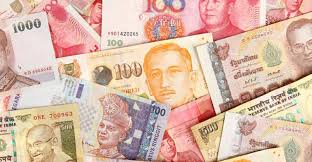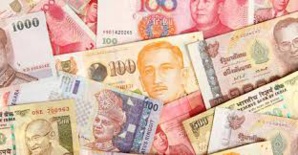Four years ago, the dollar was worth 8,500 Indonesian rupiah and Malaysian ringgit less than three. Today, one dollar goes for 14 thousand rupees and four ringgit. Both currencies have collapsed this summer to the lowest in 17 years level (and continues to fall).
However, Indonesia and Malaysia are no exception: declining commodity prices, the slowdown of the Chinese economy and the increasing likelihood of a rate hike in the US have led to the fact that 2015 was the worst for the currencies of developing countries.
Brazil and Russia are going through a recession, which led to the collapse of the real and the ruble respectively. Against the backdrop of slowing national economy, the huge current account deficit and a deepening of the political crisis, the Turkish lira depreciates rapidly. Also reduces the Chilean, Colombian and Mexican pesos, said the British magazine The Economist.
In Asia, ringgit and rupiah hold the anti record, got weaken from beginning of the year by 8.4% and 9.8% against the dollar, which is much larger than the Thai baht (6.4%) and Philippine peso (2.2%) . The currency problem is exacerbated by not only the strong dependence of Indonesian and Malaysian economies on exports of raw materials, but also the aggravation of the political situation in both countries.
Let's start with the raw material. The price of oil, have fallen half over the last year, hit Malaysia, which receives around 30% of their income from the "black gold". Indonesia imports oil, but 60% of export, however, is composed of raw materials that is troublesome. Index of commodity prices, composed by The Economist, which does not include oil, fell by almost 20% over the last year.
Thailand and the Philippines on the contrast, are large and fairly well developed industrial sector: computers and electronic components make up a significant portion of their exports.
Chinese’s slowing growth and reduced appetite for raw materials also have a negative impact on Malaysia and Indonesia. China is the main export address for the Philippines too, but the remittances of millions of Filipinos, working abroad, stimulate domestic demand, which mitigates the negative impact of declining export revenue.
The current account deficit and the fact that a significant portion of the public debt is in foreign hands, are making Indonesia especially vulnerable to rising rates in America (and outflows). Basically, for foreign investors and sovereign debt in Malaysia. The fact, that the Indonesian debts (both corporate and government) are denominated in dollars, is even more disturbing. This means that as the rupee depreciates, the price for the debt service increases.
In response to these challenges, Indonesia begins to resort to protectionism: in July, Jakarta imposed trade duties on various consumer products, including coffee, cars and condoms.
Despite numerous statements by President Joko Widodo on the need for infrastructure development, little is being done. The politician took office nearly a year ago, and investors are skeptical that Widodo able to conduct any reforms.
As for Malaysia, its gold and foreign currency reserves are rapidly declining (now under $ 100 billion), indicating that the government is attempting to artificially support the ringgit. Corruption scandal, surrounding Prime Minister Najib Razak, reinforces concern investors.
The main question is how long the crisis will last. Many predict a recovery in commodity prices; although few expect it to happen soon. The depreciation of the national currency makes Asian countries exports more competitive, but the low prices of raw materials almost completely eat the profits. Today, Indonesia's growth rate is lowest since 2009. The fall of the rupee and the ringgit also accelerates inflation. Once the Fed announces the rate increase, all these negative trends will only increase.
source: economist.com
However, Indonesia and Malaysia are no exception: declining commodity prices, the slowdown of the Chinese economy and the increasing likelihood of a rate hike in the US have led to the fact that 2015 was the worst for the currencies of developing countries.
Brazil and Russia are going through a recession, which led to the collapse of the real and the ruble respectively. Against the backdrop of slowing national economy, the huge current account deficit and a deepening of the political crisis, the Turkish lira depreciates rapidly. Also reduces the Chilean, Colombian and Mexican pesos, said the British magazine The Economist.
In Asia, ringgit and rupiah hold the anti record, got weaken from beginning of the year by 8.4% and 9.8% against the dollar, which is much larger than the Thai baht (6.4%) and Philippine peso (2.2%) . The currency problem is exacerbated by not only the strong dependence of Indonesian and Malaysian economies on exports of raw materials, but also the aggravation of the political situation in both countries.
Let's start with the raw material. The price of oil, have fallen half over the last year, hit Malaysia, which receives around 30% of their income from the "black gold". Indonesia imports oil, but 60% of export, however, is composed of raw materials that is troublesome. Index of commodity prices, composed by The Economist, which does not include oil, fell by almost 20% over the last year.
Thailand and the Philippines on the contrast, are large and fairly well developed industrial sector: computers and electronic components make up a significant portion of their exports.
Chinese’s slowing growth and reduced appetite for raw materials also have a negative impact on Malaysia and Indonesia. China is the main export address for the Philippines too, but the remittances of millions of Filipinos, working abroad, stimulate domestic demand, which mitigates the negative impact of declining export revenue.
The current account deficit and the fact that a significant portion of the public debt is in foreign hands, are making Indonesia especially vulnerable to rising rates in America (and outflows). Basically, for foreign investors and sovereign debt in Malaysia. The fact, that the Indonesian debts (both corporate and government) are denominated in dollars, is even more disturbing. This means that as the rupee depreciates, the price for the debt service increases.
In response to these challenges, Indonesia begins to resort to protectionism: in July, Jakarta imposed trade duties on various consumer products, including coffee, cars and condoms.
Despite numerous statements by President Joko Widodo on the need for infrastructure development, little is being done. The politician took office nearly a year ago, and investors are skeptical that Widodo able to conduct any reforms.
As for Malaysia, its gold and foreign currency reserves are rapidly declining (now under $ 100 billion), indicating that the government is attempting to artificially support the ringgit. Corruption scandal, surrounding Prime Minister Najib Razak, reinforces concern investors.
The main question is how long the crisis will last. Many predict a recovery in commodity prices; although few expect it to happen soon. The depreciation of the national currency makes Asian countries exports more competitive, but the low prices of raw materials almost completely eat the profits. Today, Indonesia's growth rate is lowest since 2009. The fall of the rupee and the ringgit also accelerates inflation. Once the Fed announces the rate increase, all these negative trends will only increase.
source: economist.com






